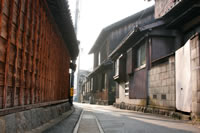History of Mirin
From Sweet Sake to Seasoning
According to various historical documents, it was in the age of provincial wars (1467 – 1615) when "mirin" was born in Japan. There are two views about the origin of mirin. One is "sweet sake" from ancient times, like concentrated sake and white sake. Sweet sake was added with alcohol to prevent corruption, which was improved later into mirin. The other is "Milin," Chinese sweet sake that tasted like trickling honey. It was brought into Japan from China.
In the Tokugawa period, mirin became popular among people as sweet, luxury sake that even women could enjoy. Mirin at that time, however, seemed not so sweet as today's mirin. The sweetness of mirin is brought forth by rice malt that turns rice starch to sugar. In those days, as there was no technique to create rice malt, they were unable to realize concentrated sweetness. Mirin, which had been popular among ordinary people as sake, came to be used as a seasoning in the course of time to draw the flavor and delicious taste of cooking ingredients. The history of mirin used as a seasoning is also long. (There are many views, including those that go back to the age of provincial wars and to the Tokugawa period.) Mirin was used in those days as a sweetener because it was available easier compared with sugar. After the manufacturing method was established for mirin as a sweetener, mirin developed further into "Hon-mirin" with a small percentage of distilled spirit and "Hon-naoshi" with a large percentage of distilled spirit. In the Meiji period (1868 – 1912) and the Taisho period (1912 – 1926), when society became stable, mirin became consumed more and more everywhere in Japan as a nourishing drink or a seasoning for dishes. In more recent years, people came to ask for sweeter and more concentrated mirin. From the end of the Taisho period to the beginning of the Showa period (1926 – 1989), mirin with rich taste like one you have today began to be manufactured.
The Mikawa area, or the eastern part of Aichi Prefecture, is blessed with water and mild weather both suitable for brewing. In this area, mirin brewage has been active for over 200 years. Even today, the area is the home of mirin manufacturing with the largest number of mirin brewers in Japan.
